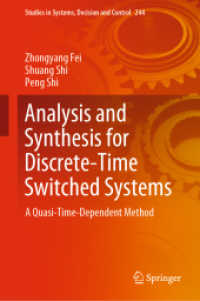- ホーム
- > 洋書
- > ドイツ書
- > Humanities, Arts & Music
- > Psychology
- > basics
Full Description
This textbook provides a comprehensive, user-friendly guide to meta-analysis and how to conduct it, using open source software and based on examples commonly found in the field of psychology. Meta-analysis is a key tool used in systematic literature reviews to synthesize research findings across studies, but despite being relatively straightforward to perform, it remains underused by psychologists. In the first section the reader is introduced to key ideas that underlie meta-analysis and how it might be best employed. Following this the reader is guided through how to run a meta-analysis of correlational studies and experimental studies using the free and open statistical software JAMOVI. In the concluding section Professor Cooke considers common issues, key debates and examines the relative merits of different analyses and different software packages.
Covers theory, key issues and step-by-step demonstrations
Includes examples worked examples familiar to psychologists and datasets
Companion videos demonstrate the methods outlined
It will provide a valuable new resource for postgraduate students and researchers in the behavioural and social sciences looking to enhance their methodological skills.
Contents
List of tables.- List of figures.- Preface.- Acknowledgments.- Chapter 1 Introduction to meta-analysis for psychologists.- Section 1 Introduction to meta-analysis.- Chapter 2 What is a meta-analysis and why should I run one?.- Chapter 3 Identifying your effect size.- Section 2 Preparing to conduct a meta-analysis.- Chapter 4 Systematic review essentials.- Chapter 5 Data extraction for meta-analysis.- Chapter 6 Quality appraisal for meta-analysis.- Chapter 7 Data synthesis for meta-analysis.- Section 3 Conducting meta-analysis in jamovi.- Chapter 8 Using jamovi to conduct meta-analyses.- Chapter 9 How to conduct a meta-analysis of correlations.- Chapter 10 How to conduct a meta-analysis of effect size differences.- Section 4 Further issues in meta-analysis.- Chapter 11 Fixed effect vs. Random effects meta-analysis.- Chapter 12 Moderator (sub-group) analyses.-Chapter 13 Publication bias.- Chapter 14 Further methods for meta-analysis.- Chapter 15 Writing up your meta-analysis.




![事例から考える刑事証拠法[連載誌面合本版] 法学教室DIGITAL LIBRARY](../images/goods/ar2/web/eimgdata/EK-1094927.jpg)



